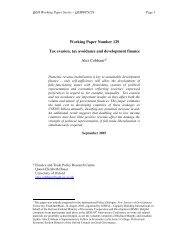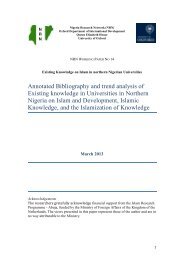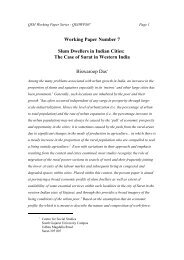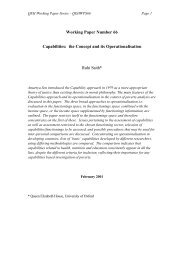Acute Multidimensional Poverty: A New Index for Developing ... - OPHI
Acute Multidimensional Poverty: A New Index for Developing ... - OPHI
Acute Multidimensional Poverty: A New Index for Developing ... - OPHI
Create successful ePaper yourself
Turn your PDF publications into a flip-book with our unique Google optimized e-Paper software.
<strong>Acute</strong> <strong>Multidimensional</strong> <strong>Poverty</strong>: A <strong>New</strong> <strong>Index</strong> <strong>for</strong> <strong>Developing</strong> CountriesAlkire & Santosattending school. Years of schooling acts as a proxy <strong>for</strong> the level of knowledge and understandingof household members. While years of schooling is an imperfect proxy, not capturing the quality ofeducation nor the level of knowledge attained, nor skills, it is a robust indicator, widely available, andprovides the closest feasible approximation to levels of education <strong>for</strong> household members. It can beconceived as a relatively good proxy of functionings that require education: literacy, numeracy, andunderstanding of in<strong>for</strong>mation. Because the unit of analysis is the household, all household membersare considered non-deprived if at least one person has five years of schooling. This variable followsthe idea of effective literacy of Basu and Foster (1998) that all household members benefit from theabilities of a literate person in the household, regardless of each person’s actual level of education. Itis also linked to the idea of external capabilities (Foster and Handy, 2008).Similarly all household members are considered deprived if any of their school-age children are notattending grades 1 to 8 of school. Once again, school attendance does not capture completion,quality of schooling, or skills. But it is the best indicator possible to indicate whether or not schoolagedchildren are being exposed to a learning environment. Given the data restrictions, we considerit to be a sufficiently good proxy of educational functionings. The intuition of considering allhousehold members deprived if one or more children are not attending school relates to externaleffects. When a child is not in school, the household’s current and future knowledge and abilities arereduced. Note that households with no school-aged children are considered non-deprived. Henceincidence of deprivation in this indicator will reflect the demographic structure of the household andcountry as well as the educational attainments. Empirical studies suggest that this indicator providesdifferent and complementary in<strong>for</strong>mation to mean years of schooling (Santos et al, 2010).Furthermore, this indicator will be immediately sensitive to policy changes, whereas mean years ofschooling will change more slowly. Moreover the indicator of children attending school is justifiedby a number of distinct sources that have attained a high degree of consensus: the MDGs includeachieving universal primary education; ‘echoing’ the MDGs, UNESCO’s Education For All 2010report specifically analyzes possible solutions <strong>for</strong> making sure that no children are excluded fromschooling; and the Unsatisfied Basic Needs approach typically includes this indicator.Health was the most difficult dimension to measure. Comparable indicators of health <strong>for</strong> allhousehold members are generally missing from household surveys. Yet the capability to live a longand healthy life is a basic capability and is also the prerequisite <strong>for</strong> much of human development. Weuse two health indicators that, although related, depart significantly from standard health indicators.The first identifies a person as deprived in nutrition if anyone in their household is malnourished.Malnutrition is a direct indicator of functionings. For children, malnutrition can have life-longeffects in terms of cognitive and physical development. Adults or children who are malnourished arealso susceptible to other health disorders; they are less able to learn and to concentrate and may notper<strong>for</strong>m as well at work.This being said, malnutrition indicators (BMI <strong>for</strong> adults, weight <strong>for</strong> age <strong>for</strong> children) are imperfect;they do not reflect micronutrient deficiencies. Also, we do not consider the problem of obesity.Moreover, some people may appear to be technically malnourished who are not (due to body type)or their nutritional status may be not be due to poverty (it may be due to alimentary disorders orfashion norms or a recent illness <strong>for</strong> example).We wish to emphasise one key feature of our indicators on nutrition that might confuse the readerand which relates to the special construction of our measure. In the MPI all household members areconsidered to be deprived in nutrition if at least one undernourished person is observed in thewww.ophi.org.uk July 2010 14













